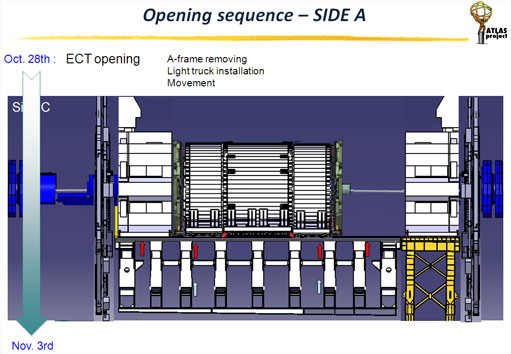
ATLAS e-News
23 February 2011
Making ATLAS accessible again
12 January 2009

From Michel Raymond's slides, in his December 1st presentation during ATLAS week
Now’s the time to make repairs in the cavern. Michel Raymond, the engineer in charge of heavy movement in ATLAS, and the teams he coordinates have opened the detector, finishing the last of the scaffolding two weeks before the winter break.
They planned an aggressive schedule to open the detector and install scaffolding access in just 19 days for each side. Due to two missed working days and other delays, this schedule stretched to 25 days, but Side C went much more to plan, requiring only 17 days.
The work started on the 20th of October – and unfortunately stopped on the 21st for the LHC Inauguration – continuing on October 22nd until 8th December. The second missed work day was due to broken elevators. “We decided it is not reasonable to use the stairs,” says Michel with a smile.
They started with Side A. The first step was to slide over the big wheels to the end of the cavern, making way to remove the shielding from the beam pipe. Next, they lowered one of the orange “truck” supports to hold the End Cap Toroid. With the ECT settled on the support, they moved the Small Wheel out, 1.1 metres from the ECT. Finally, they shifted the End Cap Calorimeter toward the Small Wheel, leaving a gap of 3.1 metres next to the barrel.
Once the spaces were all open, a special team of five technicians entered to build the scaffolding in between the two barrel segments and in between the End Cap Calorimeter and Small Wheel. The Barrel Gap scaffolding alone took six days to build, and the team toiled steadily for four weeks.
“It’s very tough work,” said Michel. He’s not sure if it will be possible to reduce the time required to make the detector accessible once it’s open.
The process for Side C is more or less identical, but some repairs were made during the opening procedures on both sides. In Side A, members of the muon group replaced two of the TGCs in EIL4 that were damaged in the overpressure. Also, drawer #44 for the Tile Calorimeter was repaired, and some of the electronics boards and low voltage power supplies on the Liquid Argon Calorimeter were removed.
On Side C, drawer #42 on the Tile Calorimeter was removed and the optical fibres on the MDT Big Wheel were replaced with fibres that will be radiation hard even at full LHC luminosity. The MDT Big Wheel on Side A will wait until spring for its new fibres. Upgrading the fibres would have waited until the next winter shutdown, but the MDT team has taken advantage of the extra time this winter.
Now that the detector is fully open, many systems will take advantage of the chance to make repairs and refurbishments until early March, when the detector begins to close once more. Michel expects that most activities can be done in parallel, but he notes: “If for instance there is some traffic jam on the scaffolding and so on, then some priority is assigned, and we just share the time.”
As for the opening and closing processes, Michel hopes to see them speed up as the team gains experience manipulating the full detector. One of the limiting factors is the heavy operations, such as lifting out the beam pipe shielding. All told, each side requires eight heavy operations which take a minimum of five days.
He is looking forward to acquiring a second set of hydraulics to work on sides A and C simultaneously from the floor. These will be installed next year.
This year, the full opening took seven weeks. Michel hopes to see that drop to four weeks in years to come.

Katie McAlpineATLAS e-News |